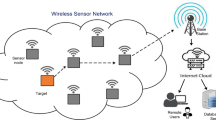Abstract
In everyday life, the Wireless Sensor Network has attained high demand increasingly since it provides more network structure to create various kinds of innovative real-time applications. One of the essential applications of WSN is target coverage. Forest, agriculture, underwater, terrorism, and other applications have used the target coverage model following its nature. Existing target coverage models are not efficient and continuous, and the application performance is poor. The above-said problem has taken into account, and various earlier research works proposed a different target coverage model, not up to the application requirement. This paper focused on providing an efficient target coverage model for various real-time applications. Thus, a complete, continuous, target coverage model is created for environmental monitoring applications using a novel Termite Flies Optimization (TFO) algorithm. Based on the termite fly's movement, distance, targets are covered by optimal sensor nodes. From the experiment, it is found that the proposed TFO algorithm outperforms the existing approaches.
















Similar content being viewed by others
Availability of data and material
Not applicable.
Code availability
Not applicable.
References
Nakas, C., Kandris, D., & Visvardis, G. (2020). Energy-efficient routing in wireless sensor networks: A comprehensive survey. Algorithms, 13(3), 72.
Kumar, D. P., Amgoth, T., & Annavarapu, C. S. R. (2019). Machine learning algorithms for wireless sensor networks: A survey. Information Fusion, 49, 1–25.
Bensky, A. (2019). Short-range wireless communication. Newnes.
Arapoglu, O., Akram, V. K., & Dagdeviren, O. (2019). An energy-efficient, self-stabilizing, and distributed algorithm for maximal independent set construction in wireless sensor networks. Computer Standards & Interfaces, 62, 32–42.
Lewis, F. L. (2004). Wireless sensor networks. Smart Environments: Technologies, Protocols, and Applications, 11, 46.
Djedouboum, A. C., Abba Ari, A. A., Gueroui, A. M., Mohamadou, A., & Aliouat, Z. (2018). Big data collection in large-scale wireless sensor networks. Sensors, 18(12), 4474.
Liu, X., & He, D. (2014). Ant colony optimization with greedy migration mechanism for node deployment in wireless sensor networks. Journal of Network and Computer Applications, 39, 310–318.
Mostafaei, H., Montieri, A., Persico, V., & Pescapé, A. (2017). A sleep scheduling approach based on learning automata for WSN partialcoverage. Journal of Network and Computer Applications, 80, 67–78.
Yick, J., Mukherjee, B., & Ghosal, D. (2008). Wireless sensor network survey. Computer Networks, 52(12), 2292–2330.
Costa, D. G., & Guedes, L. A. (2010). The coverage problem in video-based wireless sensor networks: A survey. Sensors, 10(9), 8215–8247.
Gao, Q., & Zou, H. (2010) Improving probabilistic coverage and connectivity in wireless sensor networks: cooperation and mobility. In Proceedings of the international conference on wireless communications and signal processing (WCSP '10) (pp. 1–6). Suzhou, China, 2010.
Padhi, S. K., & Pattnaik, P. K. (2010) A novel distributed protocol for randomly deployed clustered based wireless sensor network. Journal of Theoretical and Applied Information Technology, 15(1).
Gu, Y., Li, J., Zhao, B., & Ji, Y. (2009). Target coverage problem in wireless sensor networks: A column generation based approach. In Proceedings of 6th IEEE international conference on mobile ad-hoc and sensor systems.
Luqiao, Z., Qinxin, Z., & Juan, W. (2013). Adaptive clustering for maximizing network lifetime and maintaining coverage. Journal of Networks, 8(3), 616–622.
Ahmed, N., Kanhere, S. S., & Jha, S. (2010). The holes problem in wireless sensor networks: A survey. Mobile Computing and Communications Review, 9(2), 4–18.
Xing, H. D., Yun, Z. B., & Shen, T. W. (2009). Distributed connected algorithm for wireless sensor networks. Computer Engineering and Application, 45(7), 17–19.
Vimal, S., Suresh, A., Subbulakshmi, P., Pradeepa, S., & Kaliappan, M. (2020). Edge computing-based intrusion detection system for smart cities development using IoT in urban areas. Internet of things in smart Technologies for Sustainable Urban Development, 219–237.
Madhumitha, R., Harold Robinson, Y., Vimal, S., & Suresh, A. (2020). Auto encoder based dimensionality reduction and classification using convolutional neural networks for hyperspectral images. Microprocessors and Microsystems (2020). https://doi.org/10.1016/j.micpro.2020.103280
Balaji, G. N., Subashini, T. S., & Suresh, A. (2014). An Efficient view Classification of Echocardiogram using Morphological Operations. Journal of Theoretical and Applied Information Technology, JATIT, 67(3), 732–735.
Chen, A., Zhu, Y., Li, Z., Lai, T. H., & Liu, C. (2015). Is one-way barrier coverage achievable using comprehensive sensors? Computer Communication., 57, 100–114.
Tian, J., Wang, G., Yan, T., & Zhang, W. (2014). Detect smart intruders in sensor networks by creating network dynamics. Computer Network, 62, 182–196.
Aziz, N. A. A., Aziz, K. A., & Ismail, W. Z. W. (2009). Coverage strategies for wireless sensor networks. World Academy of Science, Engineering and Technology, 50, 145–150.
Katti, A. (2019). Target coverage in random wireless sensor networks using cover sets. Journal of King Saud University – Computer and Information Sciences, https://doi.org/10.1016/j.jksuci.2019.05.006
Cheng, C., & Wang, C. (2018). The target-barrier coverage problem in wireless sensor networks. IEEE Transactions on Mobile Computing, 17(5), 1216–1232.
Han, G., Qian, A., Jiang, J., Sun, N., & Liu, L. (2016). A grid-based joint routing and charging algorithm for industrial wireless rechargeable sensor networks. Computer Network. https://doi.org/10.1016/j.comnet.2015.12.014
Jaggi, N., Abouzeid, A.A. (2006). Energy-efficient connected coverage in wireless sensor networks. In AMOC, pp. 85–100.
Zhao, M. C., Lei, J., Wu, M. Y., Liu, Y., & Shu, W. (2009). Surface coverage in wireless sensor networks. IEEE INFOCOM, 2009, 109–117.
Funding
All sources of funding for the research work and their role in the design of the study and collection, analysis, interpretation of data, and in writing the manuscript should be declared.
Author information
Authors and Affiliations
Corresponding author
Ethics declarations
Conflict of interest
The authors declare that they have no conflict of interest. The manuscript was written through contributions of all authors. All authors have given approval to the final version of the manuscript.
Additional information
Publisher's Note
Springer Nature remains neutral with regard to jurisdictional claims in published maps and institutional affiliations.
Rights and permissions
About this article
Cite this article
Subramanian, K., Shanmugavel, S. A Complete Continuous Target Coverage Model for Emerging Applications of Wireless Sensor Network Using Termite Flies Optimization Algorithm. Wireless Pers Commun 127, 1479–1501 (2022). https://doi.org/10.1007/s11277-021-08700-z
Accepted:
Published:
Issue Date:
DOI: https://doi.org/10.1007/s11277-021-08700-z




